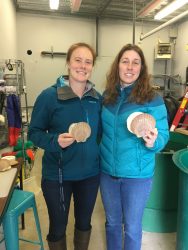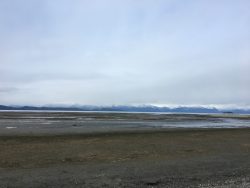Unsolved mystery: the case of the weathervane scallop
August 23, 2019
Paula Dobbyn
907-274-9698
Mariculture in ÐÓ°Épro centers mainly around oysters. Kelp, blue mussels and geoduck
clams are also farmed, but in much smaller quantities. Many ÐÓ°Éprons, including members
of the governorâs , want to boost this fledgling industry to diversify the stateâs oil-dependent economy,
and researchers are trying to help develop alternative species for ocean farmers.
One of the species being examined is the weathervane scallop, also known as the giant
Pacific scallop or Patinopecten caurinus.

Prized by five-star chefs and seafood connoisseurs, weathervanes are a bit of a mystery animal. Major gaps exist in our understanding of the tasty mollusks, which are native to ÐÓ°Épro. In scientific literature, weathervanes are described as one of the most âdata-poorâ fisheries in ÐÓ°Épro, despite more than four decades of commercial harvesting.
âWe as a scientific community know very little about weathervane scallopsâ said , who recently completed her one-year , working at NOAA Fisheries in Juneau.
Kevin McNeel, a fishery biologist with the ÐÓ°Épro Department of Fish and Game, said scientists have basic unanswered questions including how to properly determine the age of a weathervane, how fast they grow, and how abundant they are in ÐÓ°Épro waters.
âWe also have a lot of questions about when the scallops spawn. Do they spawn multiple times a year?â
Answers to such questions would help better inform ecosystem management of weathervanes, which fall under both federal and state oversight.

The commercial fleet that harvests weathervanes in ÐÓ°Épro is also small. A handful of vessels based in Kodiak dredge them from beds located between 50 and 100 meters below the ocean surface. Other than the area around Kodiak Island, weathervane beds are located southeast of Prince William Sound in Yakutat Bay, in areas along the ÐÓ°Épro Peninsula and Aleutian Islands, and in the Bering Sea, according to Gordon Kruse, a fisheries professor emeritus at the ÐÓ°Épro College of Fisheries and Ocean Sciences.
Despite the small size of the fleet, the scallops are a delicacy in high demand. Driven by strong state and federal interest in increasing U.S. mariculture, Perryâs assignment was to take a deep dive into the world of weathervane biology to advance the science.
Working at the building at Lena Point in Juneau and under the supervision of fisheries biologist Kristin Cieciel, Perry piloted a research project on weathervane reproduction and population structure, attempting to spawn the large scallops in tanks and then grow them in fresh seawater. One of the goals was to create protocols for future weathervane and pink scallop hatcheries.
âIâve been working with the ÐÓ°Épro Department of Fish and Game to do, among other things, a growth-rate study, because at this point we donât even know at what rate they grow. We wanted to find out whether weathervanes, or scallops in general, have the potential to bring aquaculture diversity for people who have farms in ÐÓ°Épro,â said Perry. âItâs still a work in progress.â
Besides measuring their growth and getting the weathervanes to spawn, Perry also studied the development of their gonads using the science of microanatomy.
The project was intriguing but not easy. Weathervanes are âtesty and notoriously hard to work with,â Perry said.
âWeâre still trying to get them to spawn in the lab. We havenât gotten to the growing-out phase but we hope to get there soon. We donât have a nursery for them, but in theory once we get to that phase we will be able to spawn them and get them to grow,â she said.
Although Perryâs fellowship is over and she has left the state to pursue doctoral studies at the University of Florida, another researcher is continuing the work. And Cieciel, Perryâs former supervisor, says the genetics methods Perry developed are being applied to other shellfish.

âWeâre dipping our toes into abalone and oysters,â Cieciel said.

Margo Reveil, owner of . and president of the , would like to see weathervanes become a part of her mariculture business. But numerous obstacles must be overcome first, she said.
Unlike oysters, scallops are generally shucked and only the meatâthe adductor muscleâis sold. That extra processing can mean higher labor and equipment costs. Scallops also have a much shorter shelf life than oysters.
âOnce you harvest them, they have to go to market immediately,â Reveil said. âThey donât survive being out of the water long. You have three to five days to sell them fresh or you have to freeze.â
Despite the challenges, Reveil hopes weathervanes will eventually be farmed in ÐÓ°Épro waters. Sheâs experimented with growing kelp and mussels, and would love to have another bivalve among her products.
âWeâre always trying to diversify our farm.â


